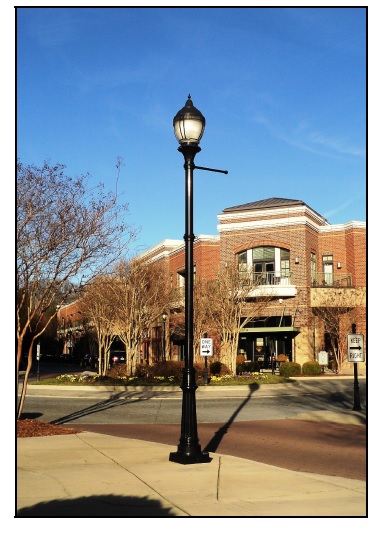Lewisville has demonstrated its commitment to visionary thinking in its short history as an organized town. Incorporated in 1991, the first Comprehensive Plan was adopted shortly thereafter in December of 1992. The plan provided the essential guidance and framework for the young town. It assessed the town’s strengths and weaknesses, opportunities, values and goals, and set forth policies by which strategic decisions were made for shaping the town.
Continuing its visionary trend, community officials recognized the need to update the town’s policy statement for its future every five years. Key recommendations of the first comprehensive plan were fully embraced by the town. The town square project and the Downtown Overlay District were two of the most notable.
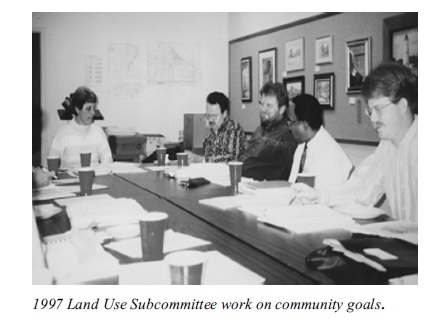
A community survey was conducted in the summer of 1996 to gain fresh insight into community desires and needs. Then, in the fall of 1996, Lewisville citizens were asked to help update the town’s future plans. A 40- member Task Force of community volunteers took on the job. Lewisville’s planning staff from the City-County Planning Board (CCPB)
provided professional guidance.
Visioning was the process used for updating existing policies and developing new recommendations. The visioning process allowed citizens to collaboratively decide what they wanted their community to become, and then to set the course on how to get there. Their emphasis was on preserving what they liked about Lewisville in the face of community changes and challenges.
The 1997 Process
A community survey was conducted in the summer of 1996 to gain fresh insight into community desires and needs. Then, in the fall of 1996, Lewisville citizens were asked to help update the town’s future plans. A 40- member Task Force of community volunteers took on the job. Lewisville’s planning staff from the City-County Planning Board (CCPB) provided professional guidance.
Visioning was the process used for updating existing policies and developing new recommendations. The visioning process allowed citizens to collaboratively decide what they wanted their community to become, and then to set the course on how to get there. Their emphasis was on preserving what they liked about Lewisville in the face of community changes and challenges.
Meetings were held in November and December to present background information. Then, in January 1997 a public forum, a telephone hotline, and a visioning workshop were held to gather ideas to determine what Lewisville should be in the year 2015. The ideas generated during those events and the community survey were used to produce a long-range vision which expressed the ideals of the community. This vision provided the framework to update the plan. In all, 164 people were involved in preparing the next iteration of the Comprehensive Plan.
Over the next several months, the Task Force worked in subcommittees to revise, update and develop new policies to help achieve the community vision. Developing a vital downtown, while preserving the rural, pastoral character of Lewisville were the essential elements of the citizens’ vision for 2015.
The 2000 Process
The next update to the Comprehensive Plan was undertaken by the Lewisville Planning Board as part of their annual plan of work. Their goal was to:
• review each item in the plan;
• determine whether it had been completed or whether it was in the process of being completed;
• determine whether the completion goal was still the same;
• determine whether the action should be referred to another town board or committee; and/or
• determine whether an item should be added.
Results of the 1997 survey were also used as background information for this update.
The 2005 Process
Three Task Forces were formed in the summer of 2004 to review and revise the 20-year Comprehensive Plan. Each Task Force consisted of citizens, supported by staff, who utilized the results of a town-wide survey as one of the resources.
Plan Organization
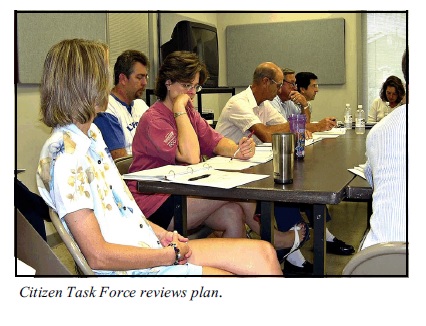
The Comprehensive plan Update for 2005 contained three main sections:
1. Introduction with process, plan organization, community profile and community vision.
2. Nine chapters which presented action plans covering topics facing Lewisville at that time:
• Land Use
• Transportation
• Downtown
• Natural Environment
• Community Character
• Housing and Neighborhoods
• Community Facilities and Services
• Governance
• Health, Safety and Wellness (New chapter for 2005)
Each chapter was organized around a specific vision statement on the topic. Then background, goals and recommended actions were presented.
At the end of each of these chapters was an Implementation Program. This section stated specific action steps for achieving the recommended actions and ultimately the community vision. Timing of implementation steps is a critical component of long- range planning. The highest priority recommendations were those indicated by the specific year for implementation or by defining it as short term. This plan assumed that short term implementation should occur within five years. Long term implementation should occur within a five to ten year period. Additionally, many recommendations were to be implemented on an ongoing basis. The Implementation Program also assigned responsibilities to specific agencies capable of carrying out the recommended actions.
3. An appendix was attached with additional information on specific subjects.
The recommendations of the task forces were sent to the Comprehensive Plan Review Committee which took these recommendations and created the final draft of the new Comprehensive Plan. The Plan was forwarded to the Town Council for approval.
The 2010 Process
The Planning Board prepared a plan for the 2010 update. It consisted of a Stakeholders Committee, Coordinating Committee, Task Forces (4), and a Review Committee.
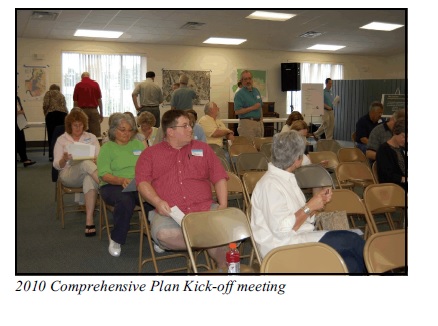
The Stakeholders consisted of Town Council Members, Planning Board members, chairs of the town’s boards and committees, the town attorney and various staff members. The chapter titled Downtown was changed to Chapter 7 Commercial Districts; and a new chapter titled Chapter 10 Citizen Engagement was added. The Chapter 6 Land Use was expanded to include the Vienna Business District and Rural Overlay areas. The committee suggested the members of the Coordinating Committee and Review Committee. (Task Force members were volunteers who had attended the public kick-off meeting.) A proposed time line for completion was approved.
The Coordinating Committee was responsible for providing Task Force oversight, management, guidance, background information, conflict resolution, and the process for completing their assigned chapters.
The Task Forces were charged with reviewing their assigned chapters and updating as necessary.
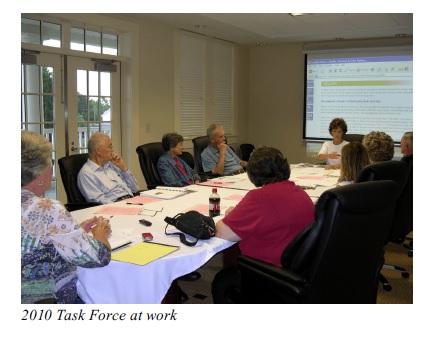
The Review Committee was established to review the work of the Task Forces so that the completed document would be uniform and consistent.
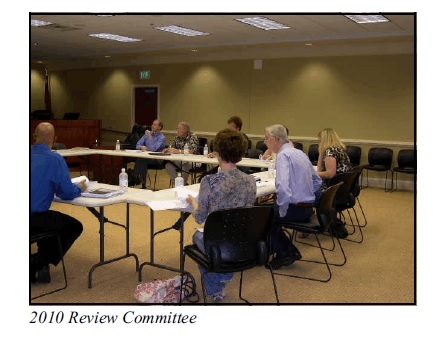
The 2015 Process
In early spring of 2014, the Planning Board determined that the first step in updating and informing the 2015 Comprehensive Plan process would be to review and assess the 2010 process. Specifically, the goals were to reinforce past successes and modify future actions based on lessons learned. The Planning Board reviewed the 2011 After Action Report, solicited input from previous Plan participants and had robust discussions and brainstorming. Three key goals emerged from the assessment: 1) To ensure consistent and equal review across chapters; 2) To maximize public input utilizing multiple methods and tools; and 3) To tap relevant reference documents gathered, published, adopted, and/or engaged over the past 5 years. Based on those imperatives, the Planning Board outlined a procedure with timeline for 2014/2015; submitted it to Town Council; and began its update in the fall of 2014.
Although the Planning Board served as the primary review committee, its key responsibility was to advocate for and collate the wishes and desires of the public based upon feedback received over the previous five years. Public priorities were gathered based on the results of the 2014 Town Survey, as well as three separate Citizen Input Sessions held February through April of 2015.
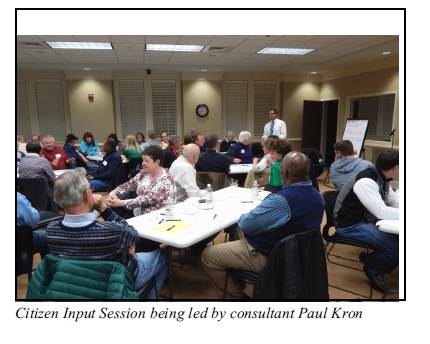
The Citizen Input Sessions were very well attended with most meetings having over sixty (60) participants. Each session was facilitated by a representative of the Piedmont Triad Council of Governments (PTRC). Prior to the beginning of each session, participants were asked to complete a mini-survey covering key topics to be discussed.
This information, along with the responses given at the session, were indexed by PTRC staff and was used to create a matrix of all available information that could be used to update the Comprehensive Plan. Other information used within this matrix was from WS/FC Legacy Plan, Lewisville Greenway and Pedestrian Connection Plan, Citizen Survey and the EPA Downtown Workshop results.
Additionally, the Planning Board reached out to existing boards and committees to gather any specific input from their various perspectives. Content experts, stakeholders, relevant documents, and town staff provided ongoing input and expertise.
In early May, 2015, the Planning Board began a detailed chapter by chapter review, inserting this information into the 2010 text as well as updating other statistical information found within the document. Final formatting and the addition of new pictures, maps and other graphics were completed in August of 2015.
Changes made for this document were:
• moving the Vision statement to the end of each chapter;
• combining Housing & Neighborhoods and Commercial Districts into Land Use;
• renumbering the chapters to accommodate the chapter changes;
• expanding demographics; and
• amending the Environmental Quality and Sustainability in the Appendix to reference chapters in this Plan, Legacy, and the UDO.
The final draft was submitted to the Town Council for their review in September 2015.
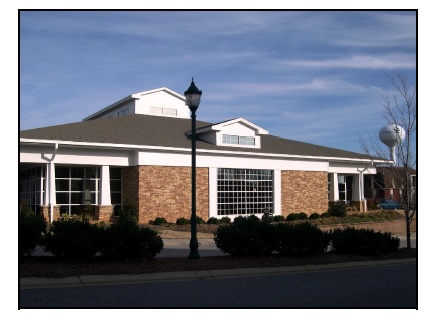
Our Community Vision of the Future
Lewisville in the year 2035 will continue to be a desirable place to live, work and recreate. Lewisville’s rural landscape, featuring woodlands, open fields, lakes, rolling hills and small streams, has been preserved through conscientious conservation efforts in the face of growth pressures. Quality of life will be enhanced through efforts by the town, citizens and businesses by managing growth and will be guided by citizen-developed long-range plans. Development will be carefully managed to minimize impacts on the environment and costs to the community and will continue to enhance the character of the town. Cooperative relationships with Winston-Salem, Clemmons, Tobaccoville and other surrounding communities will continue to benefit Lewisville. Downtown’s small-town atmosphere will continue to reflect the town’s rich heritage, and its diverse and dynamic spirit. Our transportation system will provide a wide variety of transportation options, resulting in advantages which include improved traffic flow and air quality, safety, health and well-being. Lewisville will continue its commitment to improving the quality of protecting its pastoral character and maintaining strong, diverse housing and neighborhoods while sustaining a low overall tax rate for community residents.
This vision will guide decision makers into the future.
